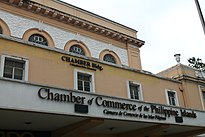|
Chamber of Commerce of the Philippine Islands
La Cámara de Comercio de las Islas Filipinas,[1] widely known today as The Chamber of Commerce of the Philippine Islands,[2] is the oldest business institution[3] in the Philippines, having been founded in 1886. The Chamber traces its roots back to the Spanish period when the King of Spain, Alfonso XII through Queen Regent Maria Cristina, issued a Royal Decree on April 9, 1886 creating similar institutions for all Spanish colonies. The Camara de Comercio de Manila was formally organized and presented to its General Assembly on May 24, 1887, and on June 17, 1887 its statutes and by-laws were initially approved by the Gobierno Superior of the Philippines; and finally approved by Her Majesty, the Queen Regent of Spain, Maria Cristina, on February 9, 1888. Sr. Don Joaquín María Elizalde was its first President, followed in 1890 by Sr. Don Francisco Godínez, and in 1895 by Sr. Don José de Echeita. After the Spanish–American War in 1888 and the situation settled down, on July 19, 1903, the Camara de Comercio de Manila held its first formal session, with the Philippine Governor-General William Howard Taft as its Honorary President and Don Francisco Reyes as the first Chamber President. Chamber PresidentsA chronological listing of the Chamber's presidents and their terms:
The FoundersAmong the founders of the Chamber were representatives of the cross-section of the economy. They were: Don Juan Rodriguez, shipbuilder; Don Miguel Velasco, real estate owner; Sr. Rogaciano Rodriguez, businessman; Sr. Francisco Reyes, banker, who was the first president from 1903-1904; Don Ricardo Aguado, businessman; Sr. Teodoro Yang-co, real estate owner; Sr. Luis Hidalgo, businessman; Don Pedro A. Roxas, real estate owner and businessman; Sr. Rafael Reyes, real estate owner and industrialist; Sr. Tomás Sunico, industrialist; Sr. Vicente Somoza Cua-Peco, real estate owner and businessman; Dr. Aristón Baustista, industrialist; Don Vicente D. Fernández, attorney-in-fact of Don Pedro P. Roxas; Sr. Telésforo Chuy-dian, real estate owner and businessman; Don Bernandino Hernandez, businessman; Sr. Faustino Lichauco, real estate owner and importer; Don Ramón Soriano, real estate owner and importer; Sr. Tomas Argüellles, architect; Sr. Ignacio Sy-yap, businessman; and Don Rafael del Pan, lawyer. First MeetingThe first organizational meeting of the founders was held at the residence of Don Juan Rodriguez on Calle Vives in San Nicolas District. It was presided by Don Miguel Velasco. In this meeting, the group adopted "Cámara de Comercio de Manila" as the name of the organization. It was later changed in 1919 to "Chamber of Commerce of the Philippine Islands / Camara de Comercio de las Islas Filipinas".[7] American Period (1903-1946)The change of sovereignty in the country from Spanish to American changed the tenor of business in the islands. Vicente Madrigal, Juan B. Alegre, Jose V. Ramirez, Alfonso M. Tiaoqui, Vicente P. Genato, Manuel E. Cuyugan, Vicente T. Fernandez and other prominent members of the Camara proved themselves leaders in espousing improved business relations in the Philippines.[8] On May 3, 1915, the members of the Camara de Comercio Filipinas amended its by-laws, and on June 19, 1915, its Escritura Social was ratified. By 1919, English began to be used instead of Spanish, thereby the Cámara was also officially referred to in documents as the Chamber of Commerce of the Philippine Islands. On July 17, 1933, During the 3rd session of the 9th Philippine Legislature, the Secretary of Agriculture and Commerce was authorized to sell to the Chamber a land for its building[9][10] and approved therein on December 6, 1933. On September 15, 1934, The Chamber was issued title to its own land, and through the contributions of private businesses, The Chamber's 3-storey building, designed by the architect Juan Arellano,[11] was built and inaugurated in 1937 with Philippine President Manuel Quezon officiating[12] with then-President Aurelio P. Periquet y Ziálcita. After the end of World War II, upon the attainment of Philippine independence, on April 6, 1949, the Securities and Exchange Commission of the Department of Commerce and Industry issued a Reconstruction of Records of the Chamber of some lost documents where the Chamber was named as Cámara de Comercio de las Islas Filipinas (and henceforth, Chamber of Commerce of the Philippine Islands).[13] Official PublicationThe Early COMMERCE YearsBefore the Chamber’s founding, the necessity for unilaterally voicing the interests of the business community in the Philippines was a dismissive concept. However, manifold concerns confronting the conduct of business emboldened the Chamber towards issues essential to the material progress of the country. The Chamber’s official publication, named the “Revista de la Cámara de Comercio de las Islas Filipinas” released its maiden issue in 1927, subsidized by Leopoldo R. Aguinaldo (who became a Chamber president), and who later renamed the magazine’s name to “COMMERCE”. The change in name was made to identify it as the official organ of the Chamber. COMMERCE Magazine had two sections for English and Spanish readerships, but was later reformatted into a wholly English language publication. It was printed in a deluxe format, on heavy paper, which made it the most expensive, authoritative and exclusive trade publication in the Philippines.[14] In January 1952, Dr. Jose R. Katigbak was appointed to manage the magazine, assisted by M.M. de los Reyes. The Board of Editors headed by Dr. Katigbak included Domingo Abadilla and Hilarion Vibal as staff, followed by other prominent members of the Chamber who took turns in running the publication, such as Teofilo Reyes, Hilarion Vibal, Benito Medina, Carlos de Lara and George Yulo. The Later COMMERCE YearsThe publication of COMMERCE was halted during the Philippine Martial Law regime. In 2015, José Luis U. Yulo Jr. (56th President of the Chamber) and Denissa G. Venturanza (Executive Director) decided to revive the publication. Currently, COMMERCE Magazine (Philippines) is issued regularly on a quarterly basis. Images   References
|
||||||||||||||||||||||||||||||||||||||||||||||||||||||||||||||||||||||||||||||||||||||||||||||||||||||||||||||||||||||||||||||||||||||||||||||||||||||||||||||||||||||||||||||||||||||||||||||||||||||||||||||||||||||||||||||||||||||




